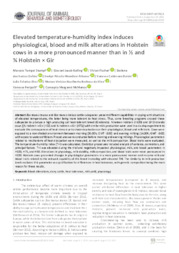Elevated temperature-humidity index induces physiological, blood and milk alterations in Holstein cows in a more pronounced manner than in ½ and ¾ Holstein × Gir.
Elevated temperature-humidity index induces physiological, blood and milk alterations in Holstein cows in a more pronounced manner than in ½ and ¾ Holstein × Gir.
Author(s): STUMPF, M. T.; KOLLING, G. J.; FISCHER, V.; DALTRO, D. dos S.; ALFONZO, E. P. M.; DALCIN, V. C.; DIAS, L. T.; SILVA, M. V. G. B.; PERIPOLLI, V.; MCMANUS, C. M.
Summary: Bos taurus taurus and Bos taurus indicus cattle subspecies present different capabilities in coping with situations of elevated temperatures, the latter being more tolerant to heat stress. Thus, some breeding programs crossed these subspecies to produce a high producing yet heat-tolerant breed (Girolando). Nineteen Holstein (H100) and 19 Girolando cows [(½ Holstein × Gir (H50) and ¾ Holstein × Gir (H75)] with similar milk production were used in a six-day experiment to evaluate the consequences of heat stress due to shade deprivation on their physiological, blood and milk traits. Cows were exposed to a non-shaded environment between morning (06:00h; GMT -3:00) and evening milking (14:30h; GMT -3:00) with access to water ad libitum. Procedures were conducted before morning and evening milkings. Physiological parameters related to mechanisms of heat dissipation were measured, as well as the milk composition. Blood traits were evaluated. The temperature-humidity index (THI) was calculated. Statistical procedures included analysis of variance, correlation, and principal factors. THI was elevated during the trial and negatively impacted physiological, milk, and blood parameters in H100, H75, and H50. Alterations in physiology, milk stability, milk composition, and blood traits were more pronounced in H100. Holstein cows presented changes in physiological parameters in a more pronounced manner and in some milk and blood traits related to the reduced capability of this breed in dealing with elevated THI. The similarity in milk production levels excludes this parameter as a justification for differences in heat tolerance, with genetic composition being the main reason for these results.
Publication year: 2021
Types of publication: Journal article
Unit: Embrapa Dairy Cattle
Observation
Some of Embrapa's publications are published as ePub files. To read them, use or download one of the following free software options to your computer or mobile device. Android: Google Play Books; IOS: iBooks; Windows and Linux: Calibre.
Access other publications
Access the Agricultural Research Database (BDPA) to consult Embrapa's full library collection and records.
Visit Embrapa Bookstore to purchase books and other publications sold by Embrapa.

